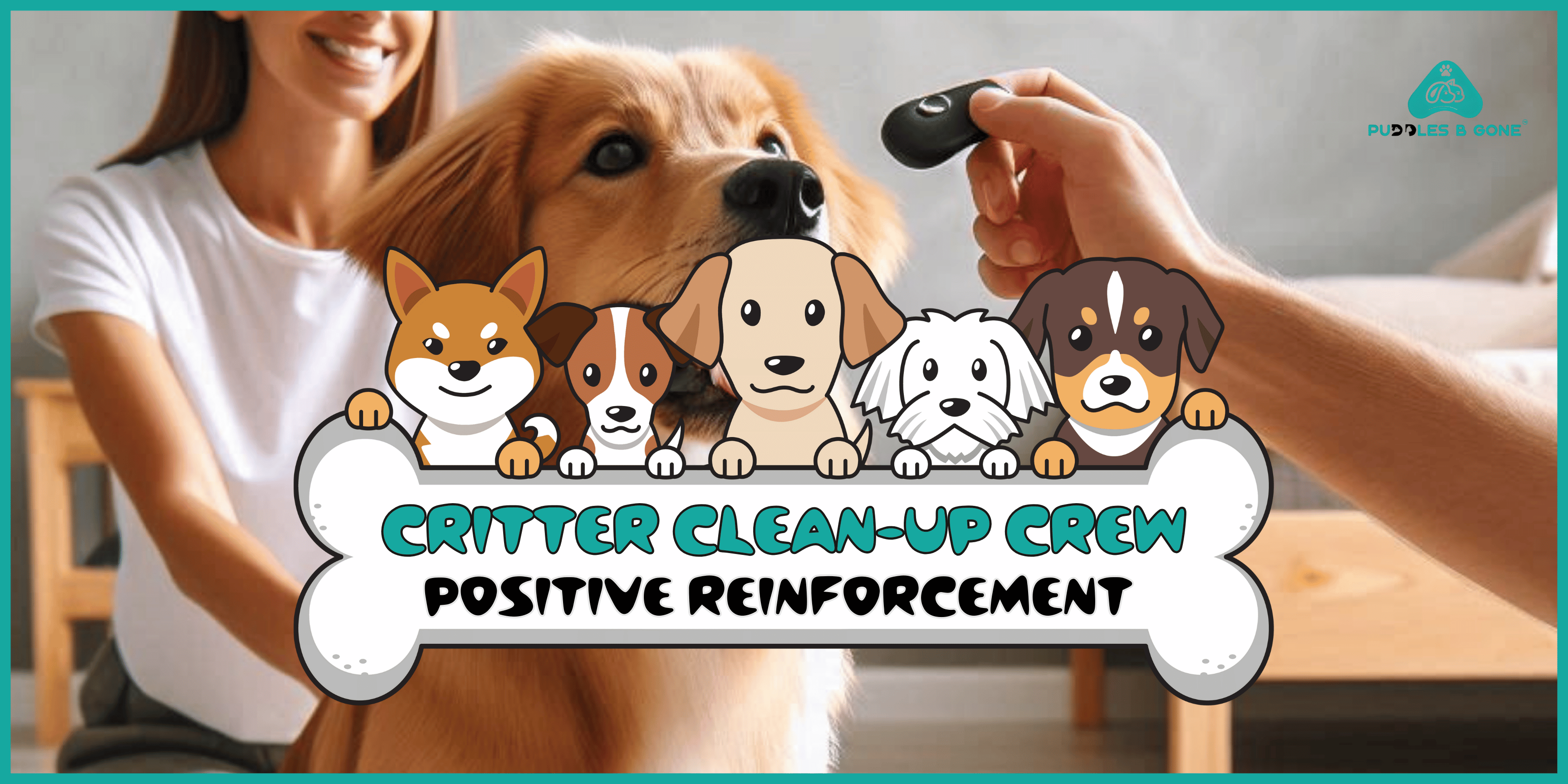Ever wonder why some dog training methods build a stronger bond? Positive reinforcement training stands out. It’s loved by pet owners and trainers alike, promising results that are both effective and kind, making training a way to change behavior with compassion.
This guide will help you understand positive reinforcement training better. You’ll learn how rewarding good behaviors changes how your dog acts. It also builds a better bond between you and your pet through the right cues and rewards. Puddles-B-Gone offers free webinars to help you get started and refine your skills with positive reinforcement.
Key Takeaways
- Positive reinforcement for dogs involves rewarding desired behaviors immediately to cement the right associations.
- Consistent use of cues and rewards is crucial for successful training outcomes.
- Common verbal cues include “sit,” “stay,” and “come,” which, paired with body language, enhance communication.
- Positive reinforcement techniques can prevent undesirable behaviors, such as door-darting and jumping on people.
- Using a mix of rewards like food treats, praise, petting, and toys can maintain engagement and motivation.
What is Positive Reinforcement?
Positive reinforcement is a popular dog training method. It rewards dogs for good behavior, encouraging them to repeat it. This approach is based on B.F. Skinner’s theory of operant conditioning, using a reward after a behavior to increase the likelihood of that behavior happening again.
Definition and Principles
Positive reinforcement gives a reward right after a dog shows a certain behavior. Rewards can be treats, toys, or praise. Giving rewards quickly and consistently is key, helping dogs understand which actions are good. The American Veterinary Society of Animal Behavior supports reward-based methods, noting that such methods make dogs more motivated and happy.
Positive reinforcement builds trust and makes learning effective, avoiding the downsides of harsh methods. This creates a better and safer training space.
Comparison with Other Methods
Positive reinforcement strengthens the bond between dogs and their trainers. Unlike punishment, it does not cause fear or stress, making learning safer and more fun. Dogs learn better and trust their trainers more. This method offers many reward options, including treats, toys, praise, and petting, tailored to what a dog likes for more effective training. Consistency among everyone in the dog’s life helps the dog understand and trust the training process.
Why Use Positive Reinforcement in Dog Training?
Positive reinforcement in dog training offers many benefits. It supports good behavior without punishment, strengthens the bond between you and your pet, and is both humane and ethical.
Benefits for Your Dog
Effective positive reinforcement training creates good feelings for your dog when they do something right, strengthening your bond. Studies show this method can reduce fear and aggression in dogs, motivating them to maintain good behavior and improve their overall behavior.
Strengthening the Human-Pet Bond
Positive reinforcement enhances your relationship with your dog. By rewarding desirable behavior, trust grows between you and your dog, making training enjoyable for both. Tools like clickers indicate the exact moment your dog does something right, leading to a reward.
Ethical Considerations
Training dogs with positive reinforcement is a kind choice, emphasizing patience and avoiding punishment’s negative effects. Dogs show what rewards work best for them, making the training fit them perfectly. Choosing the right rewards and tracking progress are key to effective positive reinforcement training.
The advantages of using positive reinforcement with dogs are clear. This approach is better than harsh methods, building a positive, trust-filled relationship and ensuring your pet is treated well. This results in a well-behaved and happier dog.
Essential Positive Reinforcement Training Techniques
Starting positive reinforcement training with your dog is rewarding. Using specific techniques helps your pet learn good behaviors quickly and makes training fun.
Timing and Consistency
Precise timing and consistency are crucial. Reward your dog right after they do what you want to connect the behavior with the reward. Keep sessions short, 5-10 minutes, to maintain your dog’s focus. Consistent methods help your dog learn faster and understand what you expect.
Types of Rewards
Choosing the right rewards is essential. Use different rewards like food, praise, and toys to keep your dog interested. Consistency in the type of reward helps your dog know what to expect. Tailoring rewards to what your dog likes can significantly improve training success.
| Reward Type | Examples | Usage |
|---|---|---|
| Food Treats | Small, tasty snacks | Useful for immediate, high-value rewards |
| Praise | Verbal affirmations | Can be used frequently and with other rewards |
| Toys | Balls, chew toys | Ideal for play-motivated dogs |
Common Training Commands
Learning basic commands is key. Commands like “sit,” “stay,” “come,” and “leave it” are important for daily life and safety. Teaching these commands well is the foundation for more advanced training. Celebrate every small win to motivate your dog and build their confidence.
Timing: The Key to Success
It’s crucial to understand the importance of timing in positive reinforcement training. Rewards given at the right time make training more effective. This helps dogs link their actions with positive outcomes quickly.
Immediate Rewards
Giving rewards promptly is a key part of positive reinforcement training. Research shows rewarding a dog within 30 seconds of doing something good helps them connect the action with the reward, making them more likely to repeat the behavior. High-value rewards like their favorite snacks or toys keep dogs interested. They may need to repeat a new action many times to learn it well. By always rewarding good behavior, it becomes stronger and more frequent.
Shaping Behavior
Shaping behavior involves rewarding small steps that lead to the final goal. For example, to teach a dog to “shake hands,” start by rewarding them for just lifting their paw, then progress to the full handshake. Patience and knowing your final goal are necessary for this method. It helps trainers encourage each small success, celebrating every step towards the goal.
| Behavior | Incremental Step | Reward Type |
|---|---|---|
| Sit | Bending knees | Treat |
| Come | Turning towards the owner | Praise and Petting |
| Shake Hands | Lifting paw | Treat |
Types of Rewards in Positive Reinforcement
Using positive reinforcement means choosing the right rewards to boost motivation and encourage good behavior. Popular rewards include:
Food Treats
Food treats are highly effective in positive reinforcement. High-value snacks like boiled chicken or cheese are great, especially in busy places. These treats should be small, easy to eat, and varied to keep your dog interested. Treats are proven to be a top way to teach dogs new things.
Praise and Petting
Many dogs love verbal praise and petting as much as they like treats. Energetic verbal praise and lots of pets make them feel proud. This reward works well for dogs that enjoy attention. Using consistent praise words and actions helps dogs link their good behavior with positive results.
Toys and Games
Toys and games are also great rewards. Some dogs prefer playing fetch or tug-of-war over treats or cuddles. Adding toys and fun games to training makes learning exciting for them. Playing games encourages them to think and try new behaviors to get their favorite toys.
| Types of Rewards | Examples | Effectiveness | Potential Usage |
|---|---|---|---|
| Food Treats | Boiled chicken, cheese | Very High | Distractions, new skills |
| Praise and Petting | Verbal praise, affection | High | Basic commands, bonding |
| Toys and Games | Fetch, tug-of-war | High | Active engagement, energy |
Common Dog Training Commands and Verbal Cues
Mastering common training commands is crucial for effective training. Clear, consistent verbal cues are key. Commands like “sit,” “stay,” “come,” and “leave it” are basic but essential. They can be mastered with regular practice and positive reinforcement.
| Command | Method | Reward Type |
|---|---|---|
| Sit | Capturing/Luring | Treats & Praise |
| Stay | Gradual Duration | Treats & Praise |
| Come | Leash Guidance | Treats & Affection |
| Leave It | Hand Signal | Alternate Treats & Praise |
My experience shows that positive reinforcement and consistent commands work well. Keep training sessions short and effective for the best results. Start early and maintain these methods for a great relationship with your dog.
Troubleshooting Common Issues in Positive Reinforcement Training
Positive reinforcement training is effective but comes with challenges. Two common issues are using commands inconsistently and accidentally rewarding bad behavior. Addressing these issues helps improve training.
Inconsistent Command Use
Using commands consistently is crucial. If commands are used differently or only sometimes, the dog might get confused, leading to slow learning and unpredictable actions. Everyone interacting with the dog should use the same commands consistently.
- Keep commands simple and consistent: Always use the same words for commands in every training session.
- Ensure all family members participate: Everyone interacting with the dog should know and use the agreed-upon commands.
- Practice regularly: Regular training helps your dog remember commands well.
Accidental Rewarding of Undesirable Behavior
Accidentally rewarding bad behavior can encourage unwanted actions. For instance, giving a treat to stop barking might teach them that barking gets treats.
- Identify triggers: Understand what causes the bad behavior and plan how to respond before it happens.
- Use alternative rewards: Offer play or attention instead of food after stopping the undesirable behavior.
- Immediate correction followed by reinforcement: Quickly correct the bad behavior, then reinforce the good behavior.
By addressing these common issues, you can improve positive reinforcement training. Consistency with commands and careful reward management makes training smoother and more effective.
| Issue | Solution |
|---|---|
| Inconsistent Command Use | Standardize commands and ensure all family members use them consistently. |
| Accidental Rewarding of Undesirable Behavior | Identify triggers, use alternative rewards, and implement immediate corrections followed by reinforcement. |
Using Positive Reinforcement in Everyday Situations
Applying positive reinforcement in daily life can improve your dog’s behavior. Here’s how to use it in common situations:
Mealtime Manners
Training your dog to sit before eating is a great use of positive reinforcement. Teach them to wait before receiving their food, rewarding them with a treat or praise. This promotes patience and strengthens your bond.
Preventing Door-Darting
Door-darting can be a big problem. Use positive reinforcement to reward your dog for staying calm by the door instead of running out. Treats or affection for staying put will help curb this behavior.
Encouraging Calm Behavior
Encourage your dog to stay calm by rewarding them for remaining quiet and still. This creates a more peaceful environment by reinforcing good behavior.
| Scenario | Technique | Reward Type |
|---|---|---|
| Mealtime Manners | Sit before eating | Treats, Verbal Praise |
| Preventing Door-Darting | Stay by the door | Treats, Affection |
| Encouraging Calm Behavior | Reward quiet times | Treats, Petting, Praise |
Using positive reinforcement in everyday situations helps your dog behave better and enhances the bond between you. Consistency is key for the best results.
When to Switch from Continuous to Intermittent Reinforcement
Switching from continuous to intermittent reinforcement is an important step in training. Continuous reinforcement helps build a strong link between behavior and reward and is great for teaching new behaviors. However, once the behavior is learned, switching to intermittent reinforcement can make it more reliable and lasting.
Types of Intermittent Reinforcement Schedules
| Reinforcement Schedule | Benefits | Challenges |
|---|---|---|
| Variable Ratio (VR) | High response rate, resistant to extinction | Unpredictable reinforcement can be challenging for the trainer |
| Fixed Ratio (FR) | High response rate, predictable pattern | Brief pauses after reinforcement, susceptible to extinction |
| Variable Interval (VI) | Steady response rate | Slower rate of response, challenging to implement consistently |
| Fixed Interval (FI) | Increased responding as interval ends | Slower response rates immediately after reinforcement |
Using these partial reinforcement schedules can help make behavior improvements last longer, encouraging consistent responses without risk of behavior fading away. Careful planning of these strategies ensures successful achievement of your training goals.
Finding a Dog Trainer Who Uses Positive Reinforcement
Finding the right dog trainer is crucial for effective positive reinforcement training. Over the past 10-15 years, this method has become popular, with over 5,100 students taking online courses to learn this approach.
Trainer Qualifications
- Check certifications: Look for trainers with certifications from the Certification Council for Professional Dog Trainers (CCPDT) or similar organizations.
- Structured lessons: Good trainers offer structured lessons with clear goals. Some programs offer CEUs and discounts.
- Supportive environment: Trainers should focus on positive methods and avoid harsh techniques. Many offer personal instructor time and may provide discounts or scholarships.
Costs and Credits
Consider potential costs and credits for future courses. Half of the fee for a starter course might go towards advanced training. Advanced programs prepare trainers for behavioral consultations and real-life scenarios.
In conclusion, choose a trainer who promotes positive reinforcement. This method is supported by numerous studies, demonstrating its effectiveness in fostering good behavior and a positive relationship between dogs and their owners.
Common Mistakes to Avoid in Positive Reinforcement Training
Positive reinforcement training builds a bond based on trust and respect, but certain mistakes can lessen its effectiveness. Avoiding these common pitfalls ensures a more successful training experience.
Overusing Treats
While treats are motivating, over-relying on them can create issues. Mix in praise, petting, and play to maintain effectiveness. Be generous initially, then gradually reduce treat frequency to avoid dependency.
Ignoring Context
Training in varied environments and keeping sessions short helps dogs apply commands in different settings. Avoid repeating commands excessively to prevent making them less effective. Maintaining a positive attitude keeps dogs engaged and responsive.
Summary of Key Points
- Treats: Use sparingly and transition to intermittent rewards.
- Body Language: Incorporate with verbal cues.
- Context: Practice in various locations.
- Reward Variety: Include praise, petting, and play.
- Training Duration: Keep sessions short, 5 to 10 minutes.
- Positive Attitude: Maintain to keep dogs from shutting down.
Conclusion
Positive reinforcement training has numerous benefits, backed by research showing that dogs respond better to rewards than punishment. It enhances behavior, prevents problems, and enriches dogs’ lives. Encouraging more owners to use positive reinforcement leads to happier dogs and a stronger bond between pets and their owners.
For further assistance and to deepen your understanding, Puddles-B-Gone offers free webinars that delve into these techniques and more.








